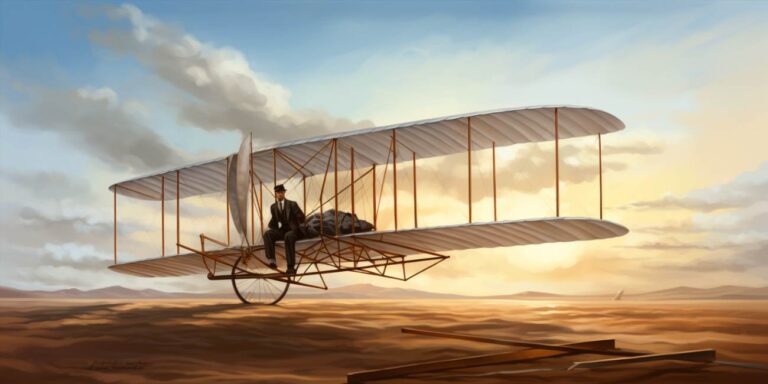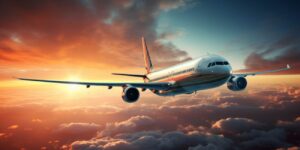The brothers, born in the mid-1860s, grew up with a fascination for mechanical contraptions and an unwavering belief that humans could fly. The turning point in their lives came in 1899 when they established the Wright Cycle Company in Dayton, Ohio, focusing on bicycle sales and repairs. However, their passion for flight remained undiminished, and they soon delved into aeronautics.
It was in the remote fields of Kitty Hawk, North Carolina, that the Wright brothers conducted their pioneering experiments. Armed with a blend of engineering brilliance and determination, they constructed a series of gliders to understand the fundamental principles of flight. These early endeavors laid the foundation for their groundbreaking aircraft.
In 1903, the momentous occasion arrived. The Wright brothers unveiled their crowning achievement, the Wright Flyer. This biplane, with its distinctive biplane configuration and a wingspan of just over 40 feet, would alter the course of history. On December 17, 1903, the world witnessed the first powered, controlled, and sustained flight as Orville Wright piloted the Flyer for 12 seconds, covering a distance of 120 feet.
This historic feat marked the birth of modern aviation. The aircraft, equipped with a 12-horsepower engine, showcased the innovative wing-warping mechanism developed by the Wright brothers, enabling precise control during flight. Their groundbreaking design principles, including the concept of three-axis control, became the blueprint for future aircraft.
Despite the monumental nature of their achievement, the initial reception was modest. The aviation community and the public were skeptical, and it took several years for the significance of the Wright brothers’ accomplishment to be widely recognized. However, as aviation technology advanced, the world came to acknowledge the pioneering efforts of Orville and Wilbur Wright.
Their legacy endures, immortalized in the annals of history as the trailblazers who invented the airplane and when. The Wright brothers’ relentless pursuit of flight not only transformed the realm of transportation but also ignited the imagination of generations to come, inspiring countless individuals to reach for the skies.
The pioneering work of the wright brothers in designing and building the first airplane
The Wright brothers, Orville and Wilbur, are renowned for their groundbreaking work in the development of the first successful powered airplane. In the early 20th century, the concept of human flight was a dream that many aspired to achieve. However, it was the innovative genius of the Wright brothers that propelled this dream into reality.
Their journey began with a comprehensive study of the existing knowledge on aviation, which they meticulously examined to identify gaps and areas for improvement. They delved into the works of notable pioneers like Octave Chanute and Lilienthal, learning from both successes and failures to refine their own ideas.
The key breakthrough in the Wright brothers’ work was their understanding of the importance of control in flight. While others were focused on achieving lift and propulsion, the Wrights recognized that without precise control, sustained flight would remain elusive. They ingeniously tackled this challenge by developing a system of wing warping for lateral control.
Orville and Wilbur’s experimental approach was another distinguishing factor. They constructed a series of gliders to test their concepts before incorporating an engine into their designs. This methodical process allowed them to gather crucial data and make informed adjustments, avoiding the pitfalls faced by some contemporaries who rushed into powered flight without sufficient testing.
The engine they designed and built for their aircraft was a testament to their engineering prowess. It was a lightweight but powerful engine that provided the necessary thrust for sustained flight. This innovation set the stage for the future of aviation, influencing subsequent generations of aircraft engines.
On December 17, 1903, the Wright brothers achieved a monumental milestone at Kitty Hawk, North Carolina. The Wright Flyer, their powered aircraft, took off from the sandy dunes, marking the first controlled, powered, and sustained flight in the history of aviation. The flight lasted a mere 12 seconds, covering a distance of 120 feet, but it forever altered the course of human transportation.
Their achievement was not only a triumph of engineering but also a testament to the perseverance and determination of the human spirit. The Wright brothers’ legacy extends far beyond that momentous day in Kitty Hawk, influencing the entire aviation industry and paving the way for the modern era of air travel.
How the wright brothers tested and refined their airplane designs
During the pioneering days of aviation, the Wright Brothers embarked on a relentless quest to conquer the skies. Their journey was marked by a series of groundbreaking innovations, rigorous testing of prototypes, and the use of pioneering techniques like wind tunnels to refine their aircraft designs.
One of the key elements in the Wright Brothers’ success was their meticulous approach to testing and refining their airplane prototypes. Rather than relying solely on theoretical calculations, they engaged in practical experiments to validate their ideas. This hands-on methodology involved constructing various prototypes and subjecting them to a battery of tests to identify weaknesses and areas for improvement.
Their dedication to perfection led them to experiment with wind tunnels, a cutting-edge technology at the time. The Wright Brothers recognized the importance of understanding aerodynamics, and wind tunnels provided a controlled environment to study the effects of airflow on their airplane designs. This innovative approach allowed them to fine-tune the shape and structure of their aircraft, optimizing their performance in the air.
Amid their numerous triumphs, the Wright Brothers also faced their fair share of challenges, encountering failed attempts that tested their resilience. These setbacks, however, were not viewed as defeats but rather as invaluable lessons. Each failure served as a stepping stone, providing crucial insights into what didn’t work and steering them toward more successful paths.
While the brothers were committed to achieving powered flight, their journey was far from straightforward. The numerous failed attempts underscored the complexity of their task. Yet, with each setback, they diligently analyzed the outcomes, iterated on their designs, and relentlessly pursued improvement.
In the Wright Brothers’ pursuit of flight, their story becomes a testament to the power of perseverance, hands-on experimentation, and a commitment to learning from both success and failure. Through their innovative use of wind tunnels, meticulous testing of prototypes, and an unwavering dedication to improvement, they laid the foundation for the modern aviation era.
The historic first flight of the wright brothers’ airplane at kitty hawk
The historic first flight of the Wright Brothers’ airplane at Kitty Hawk marked a breakthrough achievement that would forever alter the course of human history. On that fateful day, the brothers, Orville and Wilbur Wright, defied gravity and soared into the annals of aviation history. The year was 1903, and the world witnessed a mere 12 seconds that would redefine the possibilities of human flight.
With meticulous planning and engineering prowess, the Wright Brothers’ aircraft, known as the Flyer I, took to the skies on December 17th. The significance of this event cannot be overstated; it represented the first controlled, sustained, and powered flight in the history of mankind. The aircraft, a marvel of innovation, was a biplane with a wingspan of 40 feet and a 12-horsepower engine that propelled it into the air.
The breakthrough flight covered a distance of 120 feet, but its impact extended far beyond the sandy dunes of Kitty Hawk. The brothers had cracked the code of controlled flight, demonstrating their mastery over the principles of aerodynamics. This momentous achievement came after years of trial and error, countless experiments, and a deep understanding of the challenges posed by lift, thrust, drag, and gravity.
It is essential to note the challenging conditions the Wright Brothers faced. The remote location of Kitty Hawk provided the perfect blend of strong winds and soft sand, contributing to the success of the flight. The brothers’ methodical approach, coupled with their relentless pursuit of perfection, set them apart as true pioneers in the realm of aviation.
The 12 seconds in the air not only symbolized the realization of a dream but also laid the foundation for the future of aviation. The Wright Brothers’ commitment to pushing the boundaries of what was deemed possible ushered in an era of rapid advancements in aircraft design and technology. Their breakthrough achievement was not merely a personal triumph but a catalyst for the evolution of aviation on a global scale.
As we reflect on that monumental day in Kitty Hawk, where the winds of innovation carried the Flyer I across 120 feet of airspace in a mere 12 seconds, it becomes clear that the Wright Brothers’ legacy is etched in the skies above us. The journey that started with a humble biplane continues to inspire generations of aviators, engineers, and dreamers who dare to defy gravity and reach for the stars.
See also:
- The first powered flight : how the wright brothers invented the airplane
- Orville and wilbur wright pioneers of human aviation
- The pioneering history of the airplane: from the wright brothers to modern aviation
- How the airplane was invented: a story of human ingenuity and perseverance
- Which country created the first operational jet aircraft: overview of jet technology development





